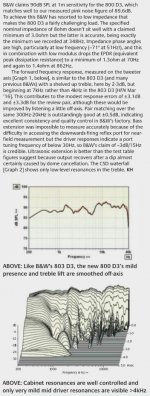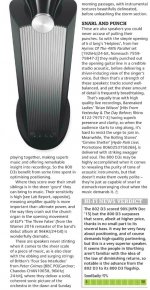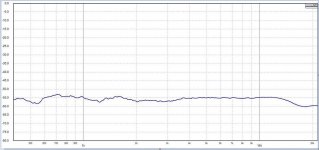I don't necessary think that "less than perfect" frequency response is the silent killer of the diamond series.
Diamond series was disappointing to me too, however, Nautilus series sounded much smoother, coherent and with a convincing sense of neutrality overall.
If I am not wrong, both speakers share the same problematic frequency response, nevertheless they sound completely different!
Technically speaking I definitely would prefer a perfect frequency response with my speakers as well, but at end of the day, they do still sound terrific.
With all that said, looking at the reviews ALL OVER THE WORLD, ALL seem to indicate the D3 series is a stellar speaker.
Although the last 10 years at B&W they seemed to have suffered a little decline in terms of sound quality among a lot of audio folks, with this series, they seemed to have done something spectacularly different to get such a wide consensus worldwide!
So they either paid all the reviewers or they must have done something extraordinary.
Dismissing a product WITHOUT having even listened at it seems foolish!
Therefore, did anybody here listened in first person and has some opinions to share?
Unfortunately I was unable to listen to them as to yet!
Diamond series was disappointing to me too, however, Nautilus series sounded much smoother, coherent and with a convincing sense of neutrality overall.
If I am not wrong, both speakers share the same problematic frequency response, nevertheless they sound completely different!
Technically speaking I definitely would prefer a perfect frequency response with my speakers as well, but at end of the day, they do still sound terrific.
With all that said, looking at the reviews ALL OVER THE WORLD, ALL seem to indicate the D3 series is a stellar speaker.
Although the last 10 years at B&W they seemed to have suffered a little decline in terms of sound quality among a lot of audio folks, with this series, they seemed to have done something spectacularly different to get such a wide consensus worldwide!
So they either paid all the reviewers or they must have done something extraordinary.
Dismissing a product WITHOUT having even listened at it seems foolish!
Therefore, did anybody here listened in first person and has some opinions to share?
Unfortunately I was unable to listen to them as to yet!
Last edited:
Last week I was able to run a comparison between Signature805, Nautilus805 and Diamond805 on same setup.
First up is the Signature 805 against Nautilus 805. The former was superior to by a long shot in every parameter: bass response was deeper and more articulated, treble was more extended and less edgy, soundstage wider, detail and resolution superior due to a cleaner and clearer presentation.
Second up: Nautilus805 against Diamond805. The Nautilus was superior in terms of natural sound and easy of flow. Also, soundstage resulted deeper and more relaxed. Diamond805 had a little leading edge on the definition of the upper register compared to the Nautilus 805 but bass wasn't as deep and integrated into the entire frequency response.
In the end I would rank the 3 speakers in the following way:
1) signature 805
2) Nautilus 805
3) Diamond 805
So the guy is selling Diamond 805 so he posted it and immediately, a couple of days later guy called him up interested and told him he was looking for an older version of the 805 (the diamond in this case) because the latest series (805D3) sounded really crappy.
The statement of that guy really left me surprised, and that is why I am still wondering if anybody has done a careful listening to the new D3 series and if so, if any opinion can be shared here as well 😕.
First up is the Signature 805 against Nautilus 805. The former was superior to by a long shot in every parameter: bass response was deeper and more articulated, treble was more extended and less edgy, soundstage wider, detail and resolution superior due to a cleaner and clearer presentation.
Second up: Nautilus805 against Diamond805. The Nautilus was superior in terms of natural sound and easy of flow. Also, soundstage resulted deeper and more relaxed. Diamond805 had a little leading edge on the definition of the upper register compared to the Nautilus 805 but bass wasn't as deep and integrated into the entire frequency response.
In the end I would rank the 3 speakers in the following way:
1) signature 805
2) Nautilus 805
3) Diamond 805
So the guy is selling Diamond 805 so he posted it and immediately, a couple of days later guy called him up interested and told him he was looking for an older version of the 805 (the diamond in this case) because the latest series (805D3) sounded really crappy.
The statement of that guy really left me surprised, and that is why I am still wondering if anybody has done a careful listening to the new D3 series and if so, if any opinion can be shared here as well 😕.
so basically they are monstrous speakers accordingly to the review?
By British standards perhaps...
Unfortunately, the full review isn't particularly helpful for prospective buyers IMO, and it's clear that the reviewer spend too little time actually reviewing.
The technical measurements raise more questions than provide answers, so we'll need to wait for Stereophile to test them using their standardised methodology.
what do you think Stereophile is going to say? They already said the 802D3 was a monstrous speaker by all standards...I don't expect any different from the review of the 800D3.
Lots of these reviews are corrupted and paid for by the manufacturers. So I don't necessarily believe their reviews unless they say the component sounded terrible, in which case you know manufacturer did not pay and there might be some real truth in what they say 🙂
This is why I was asking if anybody had yet listened to the 802D3 or 800D3 and can report their listening impressions.
Lots of these reviews are corrupted and paid for by the manufacturers. So I don't necessarily believe their reviews unless they say the component sounded terrible, in which case you know manufacturer did not pay and there might be some real truth in what they say 🙂
This is why I was asking if anybody had yet listened to the 802D3 or 800D3 and can report their listening impressions.
The last two D series and the GE tritons (or some such model) measured very closely in the mid-treble region. If they are consistent, they'll call this a failure. Honestly, this looks more like the mag got a pair with bad crossovers, or that they were measured off the listening axis. I think the 802's are meant to be listened to on the mid axis, right? It solves the treble somewhat.
If they are just being shiils, it will be the new nirvana.
If they are just being shiils, it will be the new nirvana.
Last edited:
By the way, I've never heard a B&W I hated, or one I liked either. I'm just kind of always surprised at the attention they get.
The response has the "W" shape characteristic of B&W 3-way systems with first order tweeter networks, suggesting that the crossover is a repeat of the 800D / 800D2 crossovers. The midrange response is somewhere between third and fourth order at the high end. The phase mismatches between the midrange and tweeter result in the W-shaped response, a messy radiation pattern and a (very) small listening area where things work properly.
I really wish someone at B&W would explain why they think this is a good idea, because I can't figure it out.
I really wish someone at B&W would explain why they think this is a good idea, because I can't figure it out.
The last two D series and the GE tritons (or some such model) measured very closely in the mid-treble region. If they are consistent, they'll call this a failure. Honestly, this looks more like the mag got a pair with bad crossovers, or that they were measured off the listening axis. I think the 802's are meant to be listened to on the mid axis, right? It solves the treble somewhat.
.
Ideally, measurements should be taken at the specified reference, which B&W claims is just below tweeter height, but it's desirable to measure over a +/- 30 range in the V and H plane.
Measured on axis with the mid FST, a suck-out will develop at 2-3kHz, and at the tweeter height on--axis, a suck-out is evident at 6kHz. In both cases it's because the FST and tweeter are not in-phase.
The problem is created by the decision to move the tweeter forward by a half wavelength of the crossover frequency rather than invert it and align it for time-coherence - which is the Wilson approach.
The B&W alignment means that the drivers will be 90 degrees out of phase above and below the crossover frequency (0.5 and 1.5fx) when listening on the reference axis. You can listen at a lower height to fix the suck-out at 6kHz but that creates a 180 degree relationship at 2kHz, and conversely, listening slightly above tweeter height fixes the 2kHz suck-out but moves the full 180 degrees of phase error to 6kHz.
Listening 15 degrees off the H axis reduces the dip at 6kHz because the amplitude of the FST is about 10dB down due to beaming.
So if you read between the lines it appears that the designers expect the listener to be slightly off the H axis and seated just below tweeter height.
I really wish someone at B&W would explain why they think this is a good idea, because I can't figure it out.
They claim that absolute phase is important, hence the need to have all drivers connected with the same polarity, but my guess is that the tweeter suffers from diffraction effects unless it's moved forward of everything below it.
They claim that absolute phase is important, hence the need to have all drivers connected with the same polarity, but my guess is that the tweeter suffers from diffraction effects unless it's moved forward of everything below it.
Focal did this for a while as well, to a much lesser extent. As far as I could tell all it did was prevent great phase matching and require more parts in the crossover.
Hopefully B&W's design did not require as much effort. 🙂
I misread somewhat. Here is my blog post comparing the GE, and 802 D2 and D3. They all share a great deal in messy response measurements.
A Speaker Maker's Journey: Stereophile Reviews - The Data Doesn't Lie
A Speaker Maker's Journey: Stereophile Reviews - The Data Doesn't Lie
I misread somewhat. Here is my blog post comparing the GE, and 802 D2 and D3. They all share a great deal in messy response measurements.
A Speaker Maker's Journey: Stereophile Reviews - The Data Doesn't Lie
That analysis is a bit simplistic IMHO.
You need to examine power response as well as frequency response on one (listening) axis.
When the rising response is mostly a function of acoustic gain, as the transducer becomes increasingly directional, the measured rise in amplitude isn't as audibly pronounced as you would expect, because there's a corresponding loss of off-axis energy.
Still, I think it's interesting that the old 802D measures so closely to the newer D3 - apart from the bass, and yet sounds so dramatically different.
I also smiled when the Stereophile review became freely available to the general public barely a week after it was reviewed.
And smiled again when the reviewer acknowledged in an audio forum that B&W and arranged for his old speakers to be removed and sold after the new one's arrived.
Even the most casual; readers must be aware of the symbiotic relationships that exist to the benefit of everyone except the consumer.
Art, i never read the resale situation, where did you find that?
Pretty sure it's in an AA thread. I'll look for it when time permits.
I misread somewhat. Here is my blog post comparing the GE, and 802 D2 and D3. They all share a great deal in messy response measurements.
A Speaker Maker's Journey: Stereophile Reviews - The Data Doesn't Lie
I read this blog post before, and I tried to mimic the same FR with my speakers with DSP EQ. The result is very interesting. 🙂
I read this blog post before, and I tried to mimic the same FR with my speakers with DSP EQ. The result is very interesting. 🙂
Plasnu, you should have told me, I would have sent you my files! I just sccanned the Stereophile graphs.
Anyway, please please please tell me what you found! 🙂 I was going to try that wiht my MiniDSP but real life keeps getting in the way.
Seriously, man, tell me!
I'm actually thinking of doing that for a listening party next month, as part of a larger wine, listening thing.
Erik
I read this blog post before, and I tried to mimic the same FR with my speakers with DSP EQ. The result is very interesting. 🙂
But how can you simultaneously also mimic the off-axis response?
Fwiw, I also own a mini dsp, + Dirac live correction, and I've generated correction profiles for on-axis as well as various degrees of off-axis conditions, but I've now arrived where I started, dsp-free and with a very flat response in the listening chair.
Attachments
Art,
I only use DSP for my subwoofer, and my speakers are quite flat at my listening location without, but still I wonder what it would be like if I attempted to mimic the B&W curves.
I only use DSP for my subwoofer, and my speakers are quite flat at my listening location without, but still I wonder what it would be like if I attempted to mimic the B&W curves.
- Home
- Loudspeakers
- Multi-Way
- B&W Signature 800 upgrade diamond tweeter


